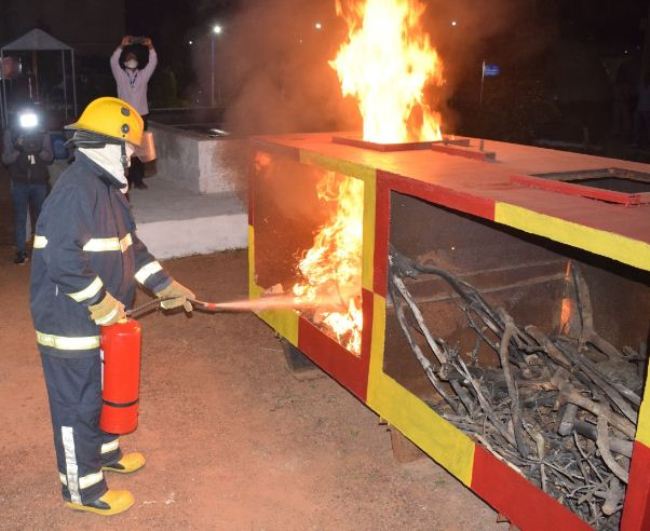Chief Minister Naveen Patnaik on Tuesday inaugurated the ‘Fire Park’, a first of its kind initiative in the country, to bring awareness on fire safety measures. He also launched a dynamic online portal, ‘AgnishamaSeva’ of Odisha Fire Service on virtual platform. Located inside the premises of the Odisha Fire and Disaster Academy in Bhubaneswar, the Fire Park will be open to the public every Saturday from 3.30 pm to 5.30 pm. Demonstrations on use of first aid firefighting equipment, rescue and disaster operations, visit to exhibition hall, screening of films and distribution of leaflets on fire safety will be part of the activities. Students from schools and colleges will be the focus group.
The Chief Minister said that the Fire Park will go a long way in educating and improving awareness on basic fire safety measures among the people, particularly the students. “It is no doubt an effort in the right direction to create a safety compliant citizenry,” he said. Stating that all the 16 fire related services are now available to the citizens on online mode in the portal www.odishafshgscd.gov.in, The Chief Minister advised the fire service department to continue to put priority on the feedback mechanism under the ‘Mo Sarkar’ to ensure hassle free and time bound services to the public. Fire Safety Regulations In India •Fire services in India come under the 12th schedule of the Constitution
under the provisions of Article 243W of the Constitution, the performance of functions listed in the 12th schedule comes under the domain of municipalities.
• Presently, fire prevention and fire fighting services are organized by the concerned states, Union Territories (UTs) an Urban Local Bodies (ULBs).
•Fire services in some states like Gujarat, Chhattisgarh etc. are under the respective concerned municipal corporations. In other remaining states, it is under the department in Home Ministry.
The regular fire service in India was brought into existence about 215 years back. Firstly, the service got set up in Bombay (1803), succeedingly in Calcutta (1822) then in Delhi(1867) and lastly in Madras (1908).
•In view of the shortcomings in the fire services in different states of the country and the need to upgrade it, the GoI in 1956 formed a Standing Fire Advisory Committee (SFAC) under the Ministry of Home Affairs, which was renamed as Standing Fire Advisory Council (SFAC) in 1980.
•Recently, fire prevention and firefighting service roviders expressed the poor condition of fire
brigades in India. They inform about the poor state of tools by saying that they are ill-equipped and unorganized.
•The National Building Code (NBC) in India states on matters of building construction and fire safety. As per the code, fire prevention and fire rotection is a subject of the state. The key responsibility for fire protection and fire prevention lies on the shoulders of the State Government.
•The fire safety rules for the prevention and protection will set in the form of Municipal By-Laws
or State Regulations. IS Codes BIS has formulated more than 150 standards on fire safety in buildings and firefighting equipment & systems and important ones are:
Code of practice for fire safety of building (IS 1641 to IS 1646), electrical generating and distributing stations (IS 3034), cotton textile mills (IS 3079), rubber and plastic (IS 11457 Part 1), libraries and archives (IS 11460), iron and steel industries (IS 13694), hotels (IS 13716), educational institutions (IS 14435); OISD Standards Oil Industry Safety Directorate (OISD) is a technical directorate under the Ministry of Petroleum and Natural Gas of Government of India, who formulates and coordinates the implementation of a series of self-regulatory measures aimed at enhancing the safety in the oil & gas industry in India.
Present Status
•As per National Crime Records Bureau figures, 17,700 Indians died – 48 people every day – due to fire accidents in 2015. Of those who died, 62% were women.
•Maharashtra and Gujarat, the two most highly urbanised states, account for about 30% of the country’s fire accident deaths, hence there is a direct correlation between the deaths due to fire-related accidents and population density associated with urbanisation.
•According to India Risk Surveys 2018, outbreak of fire poses risks to business continuity and operations and ranks India at 3rd position in fire incidents, especially in Northern and Western regions of India.
Loopholes in Fire Safety in India:
•Violation of safety norms and lack of standardization and regulation is a major cause of fire accidents, as large scale construction of false roofs in commercial buildings and multiplexes is against the national building construction code.
•High rise buildings are more prone to fire accidents as they lack an adequate in-built fire protection system that makes salvaging operations difficult.
•Poorly stored goods, even though they are not flammable, helps to spread fire and hinder fire fighters gain access to the seat of the fire or reduce the effectiveness of sprinkler systems.
•Unclear provisions of fire safety audit in terms of scope, objective, methodology and periodicity of a fire safety audit.
•Lack of adequate resources, preparedness and poor fire services fail to ensure fire safety cover to the population.
•Lack of awareness about the safety arrangements before purchasing or hiring a flat in an apartment or before starting an institution.
•Faulty Wiring: PUF (polyurethane foam) used for plastic insulation carries a high risk of accidental fire as most of the times it is exposed to electrical wiring which on becoming heated due to overloading or short circuit catches fire immediately.
•Fire Safety Audit should be made mandatory for all over India and the audit work should be entrusted to Third Party Agencies, who have expertise in it. It is reasonable to have a fire safety audit in every year in every occupancy. Above all, the success of fire prevention and fire protection mainly depend upon the active cooperation from all personnel in an occupancy. Hazard Identification & Risk Assessment (HIRA) can be focused to identify potential hazards. A comprehensive fire safety audit can address the inherent fire hazards associated with the day to day activities in occupancy and recommend measures to reduce the potential fire hazards.
•Building awareness among citizens about fire prevention and protection measures by organising fire fighting workshop once in six months in localities/Mohallas/schools with the involvement of local councillors/elected representatives.
•Fire service departments should audit critical fire prone installations (like high rise buildings, multiplexes in congested areas) periodically (once in six months) and take appropriate actions against erring establishments.
•Proper demarcation of entry and exit points in crowded buildings, installation of fire fighting equipment and their regular maintenance, periodic renewal of Noobjection certificates by building owners in order to ensure fire preparedness.









If you have any doubt please let me know.